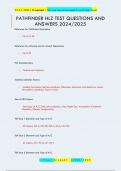2 0 2 4 /2025 | © copyright | This work may not be copied for profit gain Excel!
PATHFINDER HLZ TEST QUESTIONS AND
ANSWERS 2024/2025
Reference for Pathfinder Operations
FM 3-21.38
Reference for Airborne and Air Assault Operations
FM 3-99
HLZ Considerations
Tactical and Technical
Technical selection factors
Landing formations, Surface conditions, Obstacles, Approach and departure routes,
Atmospheric conditions, Type of Load
Size of HLZ factors
Size/type of A/C, Pilot/unit proficiency, Day/Night Ops, Atmospheric Conditions
(Humidity, Altitude, Temperature)
TDP Size 1 Diameter and Type of A/C
25 Meters, OH-6, OH-58, MH-6, AH-6, UH-72A
TDP Size 2 Diameter and Type of A/C
35 meters, AH-1W/Z, UH-1N/Y
TDP Size 3 Diameter and Type of A/C
1|Page| GradeA+ | 2 0 0 2 5
,2 0 2 4 /2025 | © copyright | This work may not be copied for profit gain Excel!
50 meters, UH-60, AH-64, SH-60, MH-60 (All 60 series)
TDP Size 4 Diameter and Type of A/C
80 meters, All Cargo A/C, MV/CV-22B
TDP Size 5 Diameter and Type of A/C
100 meters, all daytime SL, A/C of unknown origin, A/C using Land-Safe Systems
TDP Size 6 Diameter and Type of A/C
125 meters, all SL using long lines
TDP size 7 Diameter and Type of A/C
150 meters, all night SL, SL A/C using Land-Safe
Landing Formations
Trail, Echelon Left, Echelon Right, Heavy Right, Heavy Left, Diamond, Vee, Staggered
Trail Right, Staggered Trail Left
What Surface conditions are required?
Firm enough to support weight of A/C and free of loose sand, snow, debris (use
Alabama Heel stomp. Max of 2 inches)
Minimum characteristics of obstacle
18" high, wide or deep. Slope considered obstacle
Four R's
1|Page| GradeA+ | 2 0 0 2 5
, 2 0 2 4 /2025 | © copyright | This work may not be copied for profit gain Excel!
Remove, reduce, red (mark), Radio (advise pilot)
Where should you attempt to land A/C on slope
Upslope
Ground Slope Restrictions
0-7 degrees - no restrictions
7-15 degrees - skid A/C terminate at hover. wheeled A/C issued advisory and land upslope
over 15 degrees - all a/c terminate at hover
Slope formula
(Difference in elevation/ horizontal distance) * 57.3
How should approaches be made?
Long axis of HLZ and into the wind
Obstacle Buffer Ratio
10:1 or 100 meters max
5:1 or 50 meters if you may reduce
Wind max
0-9 knots cross wind
0-5 knots tail wind
departure heading varying maximum
1|Page| GradeA+ | 2 0 0 2 5




